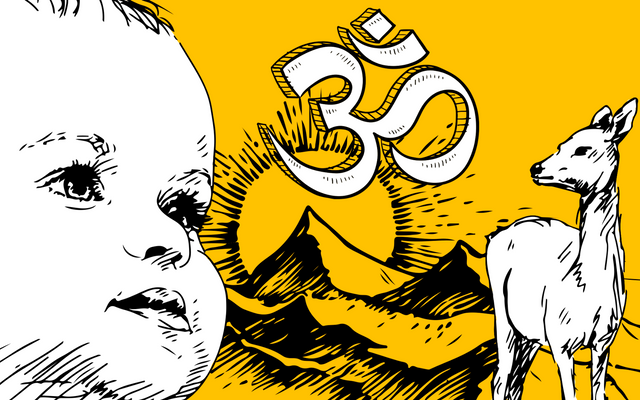ॐ [Vedic Wisdom Lessons] #3 - The Soul Can be Detected by External Signs! What? [Rational approach to the irrational]

We cannot see electromagnetic waves, but acknowledge their existence due to certain external signs. For example, we can use the phone or heat food in the microwave. How can we claim that electromagnetic waves do not exist, if we deal with them in our daily practice?
Signs and symptoms, - that’s what matters.
“Heard melodies are sweet, but those unheard, are sweeter!”
― John Keats, Ode on a Grecian Urn and Other Poems
Yes, we don't see a soul, a spiritual particle, which is mentioned in the revealed scriptures and, in particular, the Vedic literature. However, is there any rational, scientific approach that allows us to detect the soul? Can we rely on any external signs of it? The answer to this question is “Yes, they exist."
"Sat-Chit-Ananda" - three features of the soul, that are described in the Vedas.
- Sat means existence. First of all, the soul wants to exist. The soul does not want to cease to exist.
- Chit means perception, feeling. The soul wants to feel. It’s not enough for it just to exist like a stone, no, it wants to feel, see, hear, taste, smell and touch. The soul needs sensory experience.
- Ananda means "bliss, delight, happiness". This means that the soul wants not only to feel and perceive, but to do it nicely, enjoying pleasure, bliss and joy.
These are the three characteristics of the soul, which according to the Vedas, are the spiritual essence of each living being. And we can verify practically that these external signs fully manifest in us.
1. Sat.
“Still we remain, still we fight. Still we strive, still we survive.”
― Saim Cheeda
No one wants to die. When one tries to kill someone alive, he resists. He doesn't want to die and to cease to exist. We want to live longer, invent a cure for ageing and death. Where do such desires come from? Where do we get this desire to exist?
That is, the desire for existence must have a cause. We can put the question this way: "What is the reason for this desire to live and exist?" After all, the stone does not manifest this desire. You can crush or saw the stone, it doesn’t protest. But any living creature will defend itself. Why? Why does it protect itself? What is the underlying reason for this behavior? That’s the question.

2. Chit.
“I was doing something I'd never done before. And what will I be able to do tomorrow that I cannot yet do today?”
― Elizabeth Gilbert, Eat, Pray, Love
The second sign is also obvious. No one wants to lose their ability to perceive and feel. In fact, it’s always a tragedy for a human to lose sight, hearing or ability to feel, taste, smell. Vice versa, when we use, for example, binocular, telescope or a microscope, we thereby increase our ability to perceive. And we like it, we strive to see more, farther, better. We want to feel flavors more clearly and taste the food better, so we invent flavor enhancers. This desire to expand our abilities of perception the Vedas define with one short word "chit".
In other words, we can ask this way: "What is the underlying reason for this behavior? Why do the living beings value their senses so much? Why do they want to see, hear, taste, smell and touch?

3. Ananda.
“No medicine cures what happiness cannot.”
― Gabriel García Márquez
However, we don't want to feel unpleasant things, do we? We want to immerse into perception of pleasant things. For example, we don't want to look in the trash, but we enjoy seeing a rose or watching the sunrise and the moon. We want not only to feel, but do it in a pleasant way. We want to enjoy happiness. And this aspiration is defined by the sanskrit word "Ananda".

Deep nature (essence) of anything and its external signs.
So, there are male and female natures; essence of the cat and dog. And each has its own characteristics, some external signs, on which we detect the presence of this nature.
Men are usually more active, aggressive, strong. They have beards and low voice. These are the signs of the male nature. Women are more attractive, sensitive, inclined to fine arts like music, drawing, dancing, and able to bear children. These are the signs of the feminine nature. Cats meow, roll over after fall, and see in the dark. Dogs are trainable, they bark, wag tails. Salt has a salty taste. Fire manifests itself through light and heat.

What kind of fire does not shine nor heat? Then it’s not a fire anymore. This fundamental nature of anything is called "Dharma" in Sanskrit. Dharma is the nature and purpose of something. The Dharma of fire is to shine and warm. The Dharma of water is to satisfy the thirst. What water does not quench the thirst?
So that, any nature manifests itself through certain signs.
And on these grounds we can understand if we are dealing with a man, woman, cat, dog, salt, fire, and so on. But can we somehow understand that we are dealing with the soul? What are the signs we have to see in order to conclude existence of a soul?

If we see light and feel heat, that means there is a fire. But what we must discover to safely say that there's a soul?
Sat, Chit and Ananda. If something wants to exist, feel and enjoy, then we are dealing with a spiritual nature, the soul, "Brahman". This is the Vedic approach.
This spiritual nature or "Brahman" is denoted by the symbol "Om".

Am I a soul? Do those three attributes appear in my behavior?
“I'm not a body with a soul, I'm a soul that has a visible part called the body.”
― Paulo Coelho, Eleven Minutes
Do I want to exist? Yes. I resist if someone tries to take my life. Why? Because that is the aspect of my nature called "sat" - I want to exist. If someone tries to deprive me of the eye or ear, I resist. Why? Because I want to see, hear, feel, perceive. And this aspect of my nature is called "chit". Further, I always want to feel pleasure and only it. I want to enjoy and experience bliss. So this aspect of my nature, "Ananda", also manifests on the external level.
Based on this logic it is possible to conclude that my deeper nature is “Sat-Chit-Ananda". Because I can easily notice all those features in me and in others too. And not only that I find all these signs in other people, but I also see them in animals, who also strive to survive, feel and enjoy. Yes, they do it on their own, but fact is they do it. Signs of soul are obvious, thus animals have a spiritual divine spark, that Vedic literature calls "Atma", - the soul.

So, what the Vedas call the spirit (Brahman) has three characteristics that can be detected through observation.
The Vedas claim that the eternal nature of everyone is the spirit ("aham brahmasmi"). In other words, no matter how changes our body, thoughts and emotions, these three things remain unchanged: the desire to exist (sat), to feel (chit) and to pleasure (ananda).
The temporal and eternal nature.
We were kids and we had a children's nature. We loved playing in the sandbox and watching cartoons. We liked the lollipops and cotton candy. Then we became adults and began to express ourselves differently, our behavior changed. We began to like adult themes, watch serious movies, talk and think differently. So some part of us changed.
But note, these three things remain. We wanted to exist in childhood, and we still do. We were defensive, wanting to survive, and still are. We wanted to experience in childhood, same as now.

Yes, the external form has changed, but the essence has remained unchanged. We wanted to feel good and avoided unpleasant experiences in childhood. And we do the same now. And will always do.
All living beings, regardless of their external, temporary nature of a child, animal or adult human always keep these three attributes: sat, chit and ananda.
Thus the Vedic literature describes the nature of the spirit, referred to by the term "Brahman". Pay attention, when a person or animal dies, we do not observe all these signs no more. You can do any things you want to a dead body, it won't protest. In other words, these three attributes (sat-chit-ananda) are absent. Therefore, we can conclude that the soul is gone and it’s missing. Spiritual particle has left the body, and these three signs of a soul are gone.
A stone or a desk do not demonstrate these characteristics, so they have no soul, and the spiritual nature is not seen in them. But you can find all those signs in man, animal and even a plant.
Thus, the Vedas offer us scientific, logical and rational approach to the study of spiritual objects that are beyond the perceived reality (so called "transcendental").
When there is a description of the signs available for perception, there is the science. And where is the true science, there are true answers.
As you can see, the presence of the soul can be detected by certain signs, that cannot be seen through ordinary eyes. But what is special and unusual here? After all, we do not see many things, that we judge only by certain external signs.
Thank you for reading. I hope this has been worth your time.
In the end I would like to utter the motto of all Vedic literature.
ॐ सर्वे भवन्तु सुखिनः
om sarve bhavantu sukhinah
May all living beings be happy!

Yes it's true! Thanx. Vedic knowledge is deeply scientific. Consequently is appealing to a reasonable person.
So many write off spirituality as some kind of "mumbo-jumbo" when if we are to examine it, as in your, beautiful post... See can clearly see that science confirms it. Namaste
The vedas contain profound truths that science is beginning to confirm today. Discovering vedic thought was one of the most exciting discoveries of my life. I think another powerful way to see the unseen is to contemplate cause and effect.